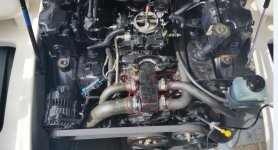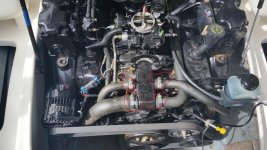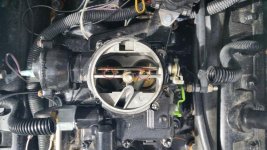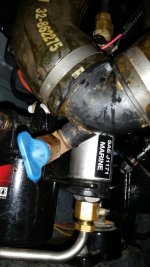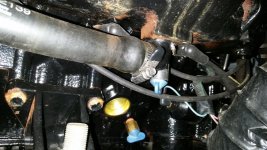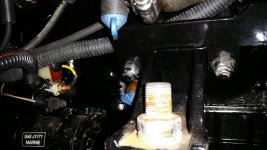Winterization steps for 2003 bayliner runabout 4.3 liter Mercruiser
|
1. Add gas stabilizer to tank and top off
Add fuel stabilizer, and take the boat/trailer for a ride down a not-so-smooth road.
This will mix the stabilizer with the remaining fuel.
|
2. Install ear muffs to outdrive with hose.
|
3. Turn on water and start engine. Let run until temp guage is reading normal or 30 minutes to be 100% safe. (t-stat is open) This allows good flushing of the engine.
Why flush an engine that has been in fresh clean lake water???
Drain the remaining lake water.... and you'll be just fine.
|
4. Turn off engine and water.
|
5. Change oil, oil filter with pump,(gas filter, and out-drive lube) optional?
Change oil and filter cartridge, run engine and look for any leaks near the oil filter.
|
6. Turn water back on and start engine. Check for leaks.
|
7. Turn off engine and water.
|
8. Locate all drain plugs on engine and remove. There are 5 blue butterfly plugs on the 2003 bayliner
As said... be sure to probe these drain ports.
Rust scale can and will build up, often preventing complete draining unless these ports are probed.
|
9. Disconnect all hoses from t-stat housing and pour antifreeze into each util see coming out drains.
Just plain ole Air won't freeze expand and cause damage to your expensive cast iron components.
Adding antifreeze will give you that "feel good" feeling only!
The amount of rust that will occur during the layup period, will be paled by comparison to that of the rust duing the normal season.
|
10. Install all drain plugs.
Leave drain plugs out.
Place bag of plugs and note on helm wheel stating what you've done!
|
11. Remove hose from ear muffs and hook up hose to sub pump.
|
12. Reinstall hoses to t-stat.
|
13. fill a 5 gallon bucket with 4 gallons of RV AF. Drop Subpump with garden house connected to muffs connected to water intake on motor. Have 2+ gallons at the ready for adding more.
|
14. Turn on the pump, then start the engine. have someone hold ear muffs semi tight to conserve AF. (You will also need to keep an eye on the volume in the bucket and start taking those spare gallons you opened ahead of time and start pouring more AF into the bucket. Make sure the bucket doesn't run dry.)
|
15. Verify antifreeze is coming out 2 side ports at transom assy on outside.
NO, NO and NO to 11, 12, 13, 14 and 15!
Please read this write up.
http://www.amazon.com/review/R3BD7X6QC3KCFR/ref=cm_cr_pr_viewpnt#R3BD7X6QC3KCFR
|
16. Spray fogging oil into carb.
Fog the carbureted engine during your short start-up for oil filter leak checks. (DO NOT fog an FI engine!)
You can properly fog a carbureted V engine in 10 seconds or so.
Be sure to spray the fogging solution equally into each primary throttle bore (V engines).
If you miss one intake manifold plane, you will have missed 50% of your cylinders.
|
17. Turn off engine. Besure to reach this step before tank runs out of antifreeze.
|
18. Engine is now done. Clean up.
|
19. disconnect and remove batteries. Store in warm area
A good, fully charged battery (when disconnected properly), will survive the winter.
|
20. Clean boat. Vacume, armour all all vinyl, clean windows
|
21. Cover boat losely with boat cover
|
22. Store in non-heated garage
|


